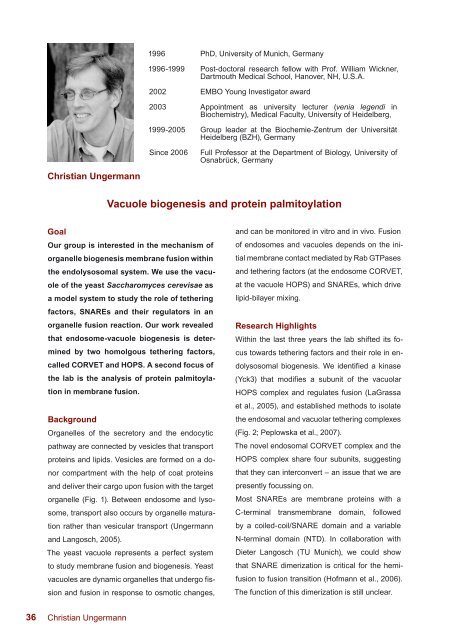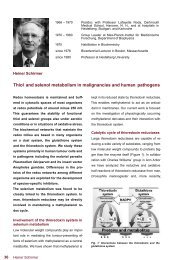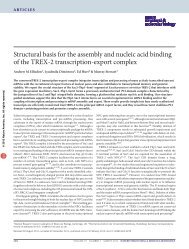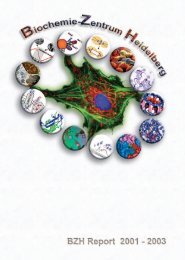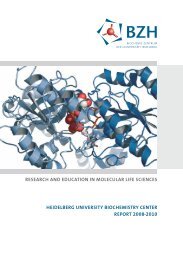Biochemie-Zentrum der Universität Heidelberg (BZH)
Biochemie-Zentrum der Universität Heidelberg (BZH)
Biochemie-Zentrum der Universität Heidelberg (BZH)
Create successful ePaper yourself
Turn your PDF publications into a flip-book with our unique Google optimized e-Paper software.
Christian Ungermann<br />
Goal<br />
Our group is interested in the mechanism of<br />
organelle biogenesis membrane fusion within<br />
the endolysosomal system. We use the vacu-<br />
ole of the yeast Saccharomyces cerevisae as<br />
a model system to study the role of tethering<br />
factors, SNAREs and their regulators in an<br />
organelle fusion reaction. Our work revealed<br />
that endosome-vacuole biogenesis is deter-<br />
mined by two homolgous tethering factors,<br />
called CORVET and HOPS. A second focus of<br />
the lab is the analysis of protein palmitoyla-<br />
tion in membrane fusion.<br />
Background<br />
Organelles of the secretory and the endocytic<br />
pathway are connected by vesicles that transport<br />
proteins and lipids. Vesicles are formed on a donor<br />
compartment with the help of coat proteins<br />
and deliver their cargo upon fusion with the target<br />
organelle (Fig. 1). Between endosome and lysosome,<br />
transport also occurs by organelle maturation<br />
rather than vesicular transport (Ungermann<br />
and Langosch, 2005).<br />
The yeast vacuole represents a perfect system<br />
to study membrane fusion and biogenesis. Yeast<br />
vacuoles are dynamic organelles that un<strong>der</strong>go fission<br />
and fusion in response to osmotic changes,<br />
36 Christian Ungermann<br />
1996 PhD, University of Munich, Germany<br />
1996-1999 Post-doctoral research fellow with Prof. William Wickner,<br />
Dartmouth Medical School, Hanover, NH, U.S.A.<br />
2002 EMBO Young Investigator award<br />
2003 Appointment as university lecturer (venia legendi in<br />
Biochemistry), Medical Faculty, University of <strong>Heidelberg</strong>,<br />
1999-2005 Group lea<strong>der</strong> at the <strong>Biochemie</strong>-<strong>Zentrum</strong> <strong>der</strong> <strong>Universität</strong><br />
<strong>Heidelberg</strong> (<strong>BZH</strong>), Germany<br />
Since 2006 Full Professor at the Department of Biology, University of<br />
Osnabrück, Germany<br />
Vacuole biogenesis and protein palmitoylation<br />
and can be monitored in vitro and in vivo. Fusion<br />
of endosomes and vacuoles depends on the initial<br />
membrane contact mediated by Rab GTPases<br />
and tethering factors (at the endosome CORVET,<br />
at the vacuole HOPS) and SNAREs, which drive<br />
lipid-bilayer mixing.<br />
Research Highlights<br />
Within the last three years the lab shifted its focus<br />
towards tethering factors and their role in endolysosomal<br />
biogenesis. We identified a kinase<br />
(Yck3) that modifies a subunit of the vacuolar<br />
HOPS complex and regulates fusion (LaGrassa<br />
et al., 2005), and established methods to isolate<br />
the endosomal and vacuolar tethering complexes<br />
(Fig. 2; Peplowska et al., 2007).<br />
The novel endosomal CORVET complex and the<br />
HOPS complex share four subunits, suggesting<br />
that they can interconvert – an issue that we are<br />
presently focussing on.<br />
Most SNAREs are membrane proteins with a<br />
C-terminal transmembrane domain, followed<br />
by a coiled-coil/SNARE domain and a variable<br />
N-terminal domain (NTD). In collaboration with<br />
Dieter Langosch (TU Munich), we could show<br />
that SNARE dimerization is critical for the hemifusion<br />
to fusion transition (Hofmann et al., 2006).<br />
The function of this dimerization is still unclear.


